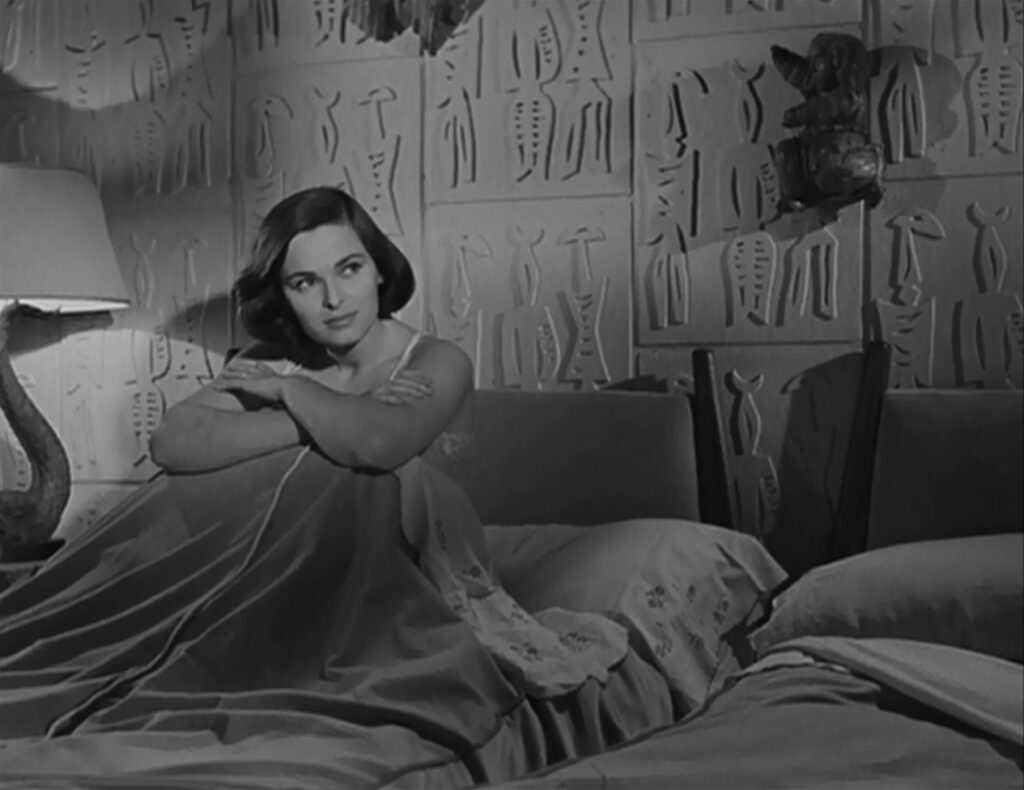
Death of a Cyclist
1955, directed by Juan Antonio Bardem
As it approaches its end, Death of a Cyclist returns to the landscape where it began with the fateful hit and run accident. Here Juan reveals that, coincidentally, this same place is also where he used to think of María José while fighting in the trenches of the Spanish Civil War. But just as the accident was more than an accident – the two lovers left the cyclist to die – the coincidence is also more than a coincidence. Given Juan’s upper class family and social circle, any Spaniard would understand that he would have fought on the Nationalist side and would already have participated in killing lower class people like the cyclist. The guilt that hangs over the story is therefore redundant – it’s a fictional expression of a real guilt that hung over Spain itself during Franco’s regime.
This symbolic transfer of guilt onto fictional characters was necessary for an honest film made in the middle of Franco’s dictatorship, but it’s not so subtle that viewers can’t easily detect a political leaning. Bardem was forced to add the final scene where María José dies, but the censor apparently objected more to the crimes left unpunished than to any anti-Franco content. To understand this movie fully, we must, ironically, subtract the ending and imagine the impact the movie would have had if it had closed, as intended, with María José killing Juan on that empty road.
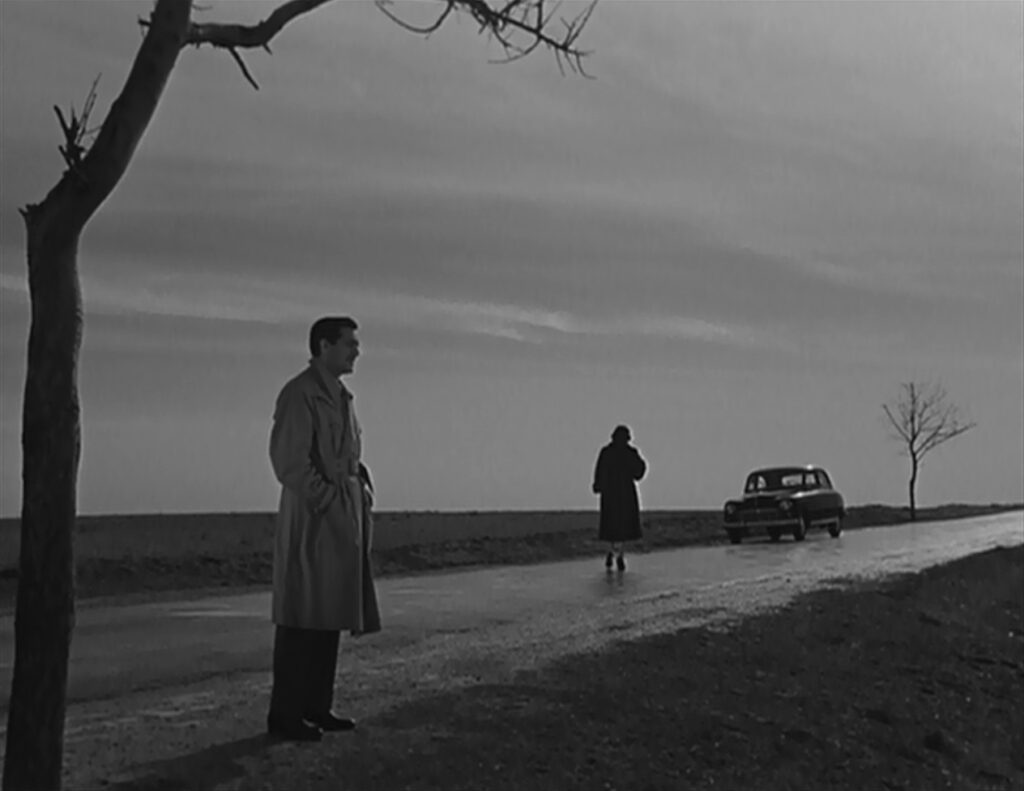
First of all, the censor must have been either wrong or disingenuous about María José getting away with two murders. Having killed Juan in the same spot as the first crime, the attention she is bound to attract would make it impossible to escape suspicion for both crimes. A long trail of circumstantial evidence – the innkeeper, Juan’s visit to the cyclist’s neighbors, María José’s panicked behavior around her husband – would weaken her defenses enough that, had she lived, viewers should have felt confident that the truth would come out. By extension the movie, like Rafa, should have sent a chill through the nerves of Franco’s allies who bore a similar kind of guilt.
This, more than any unflattering portrayal of Spain’s pro-Franco elites, is what made the film so subversive. One of the most terrifying things about fascism is that persons in power appear to act with impunity. Constantly distorting the truth, they either hide or whitewash their crimes. Death of a Cyclist undermines this faith in impunity, showing how life conspires to expose the truth. When the two lovers abandon the cyclist and let him die, it looks like a so-called “perfect crime” – the landscape is so empty in all directions that it’s hard to imagine how anyone could have witnessed them. Whether their consciences bother them or not, they seem safe from exposure… at least until Rafa unexpectedly hints at their secret. The plot hinges on this twist which terrifies the couple, but we eventually learn that it rests on a coincidence. Rafa had merely happened to see the adulterous pair driving together.
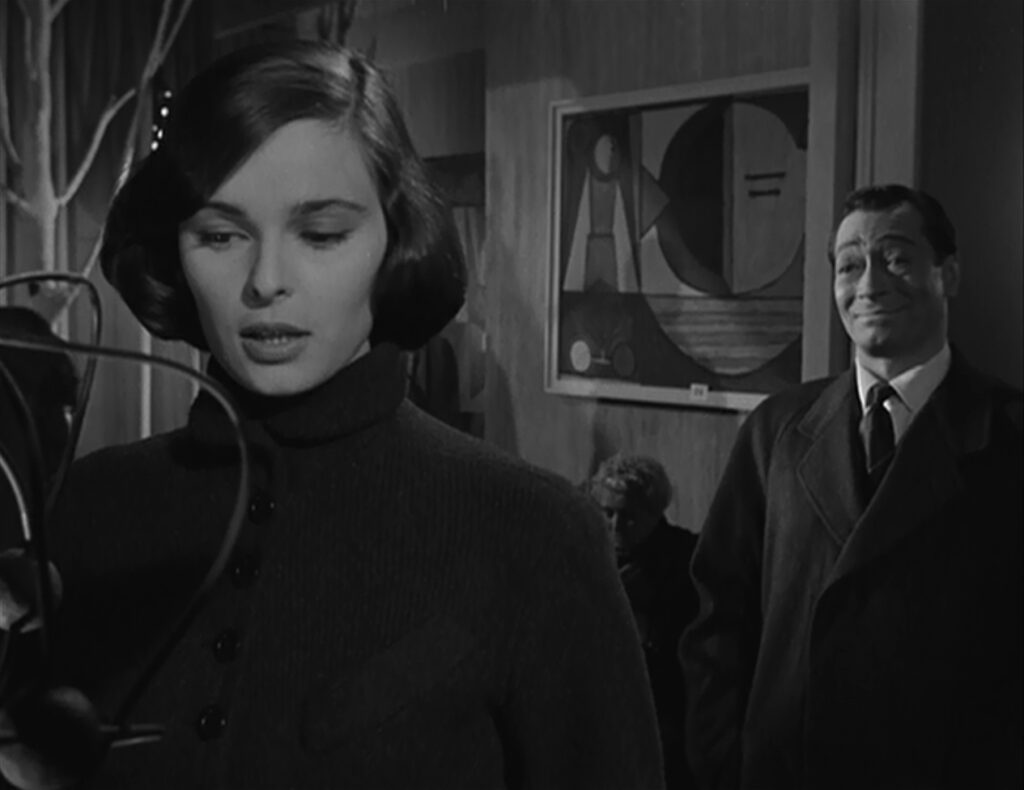
Not only does the couple’s guilt hang like a dark cloud over the whole story, but it’s reflected, refracted, and materialized at every turn. The subplot about Matilde and her geometry exam revolves around a parallel guilt, as Juan caused her to fail unjustly. When a priest emerges from a confessional to ask whether he needs anything, Juan replies, “No, it’s late,” as if he feels it’s too late to redeem himself. The walls of the inn where the couple hides their liaisons are striped like the bars of a prison cell. When the police escort Juan to his college, it appears to Rafa that Juan is wanted by the law. After visiting the cyclist’s barrio Juan is passed by an endless file of bicyclists as if the spirit of his victim were haunting him.
Amid all these tokens of guilt, numerous scenes insinuate that the world’s eyes are fixed on Juan and María José, multiplying Rafa’s accusing glare. When Rafa laughs at them at the racetrack, the film cuts to a circus where a crowd of children magnifies his laughter. The couple is hiding in the audience, but even among children they feel uncomfortable. When Juan reads the newspaper during Matilde’s exam, he imagines the eyes of his students on him, as they will in fact be later when they rally against him. At the flamenco club the tense series of glances and inaudible words drives Juan mad. No matter how safe their dirty secret is, the lovers constantly feel the oppressive weight of attention on them.
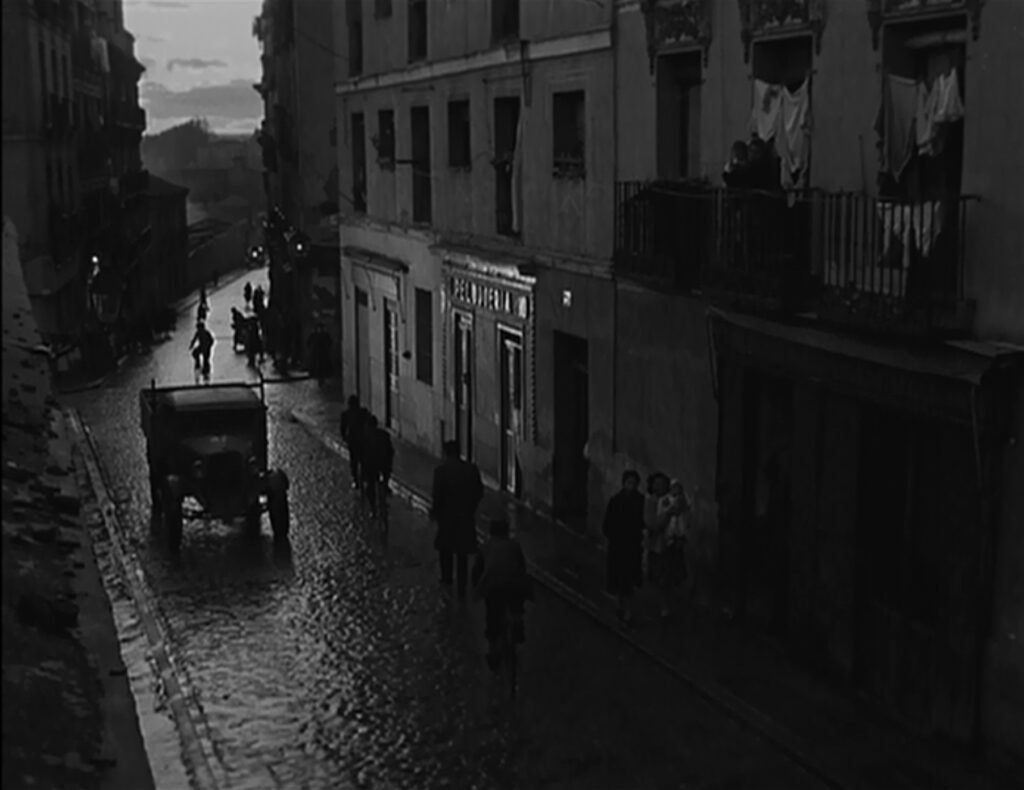
While the guilty lovers are hounded by reminders of their guilt and the danger of exposure, an omnipresent and almost mythological Truth continually threatens to rise to the surface. Each character is defined by a different relationship to the truth. María José has no love for truth and wishes it concealed at all costs. Juan fears the truth until he finally accepts it and prepares to turn himself in. María José’s husband Miguel is willfully blind to truth, vainly refusing to consider that his wife might be unfaithful to him. Rafa wants the truth to come out, but only so he can profit from it. Juan’s mother is incapable of seeing the truth, lost in her fantasy of familial grandeur. Of the major characters, only Matilde loves the truth for its own sake.
Death of a Cyclist simultaneously means to unnerve the guilty and to give courage to the victims of fascism. It wants us to feel how the coincidences and accidental symmetries that fill our lives have a way of bringing the truth to light. The plot gives us just enough coincidences to avoid looking forced – Rafa’s discovery of the couple’s affair, the way he hits on the “Death of a Cyclist” headline, and the fact that Juan had fought the war on the same plain where the cyclist is hit. While coincidences are an abundant part of life and a key agent in the emergence of truth, in a movie they tend to look suspiciously convenient; so instead of manipulating its plot, Death of a Cyclist puts its coincidences in its editing and structure.
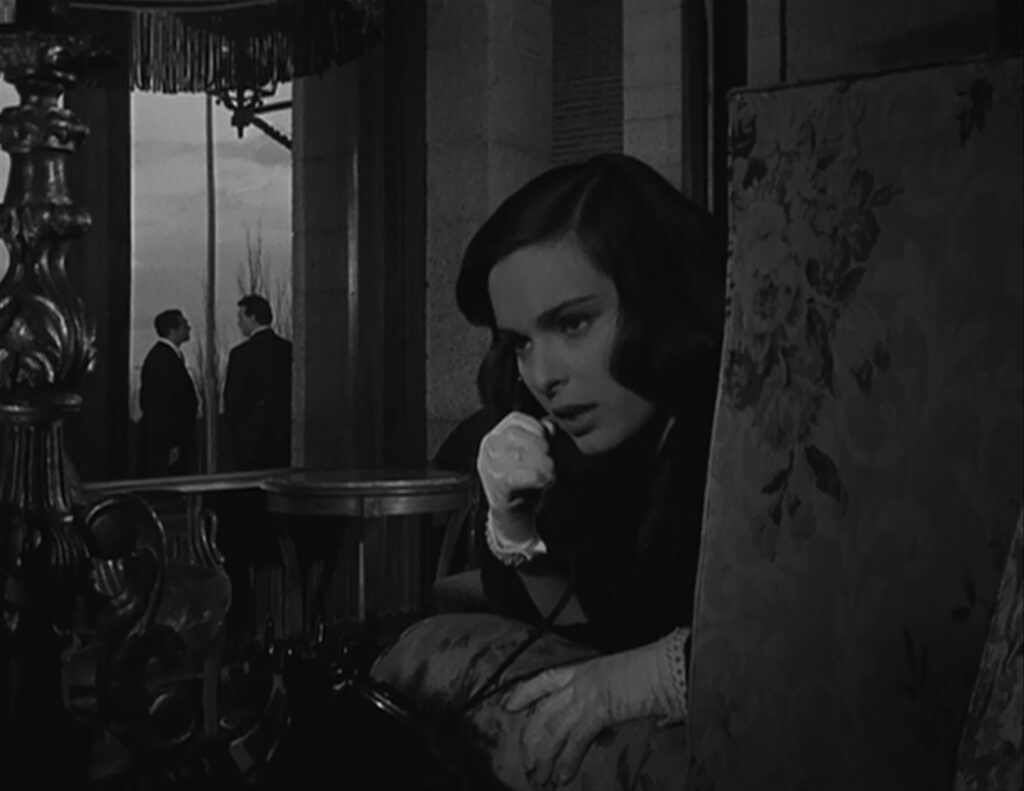
Bridging the cuts between scenes are numerous small coincidences that, together, build an uncanny sense of continuity. Rafa throws a bottle at a window, and the scene cuts to a rioting student’s bottle crashing through a window at the university. María José welcomes her husband into bed, and the next shot cuts to Juan lying down as if taking the husband’s place (as he presumably does in María José’s fantasy). Juan exhales a puff of smoke, and in another house María José waves it away in a beautifully matched cut. Speaking to his mother at home, Juan excuses his shortcomings: “For that matter I might be dean too, thanks to Jorge, but…” and his sister at the American embassy finishes the sentence: “…my brother Juan is a failure.” A rich woman at a wedding reception calls children to come and eat, followed by a peanut vendor in a poor neighborhood summoning children with a horn. At least 22 such cuts link disparate scenes, showing a world where a unitary truth binds society across geography and class divides. In a world where everything is so thoroughly connected, criminals and tyrants – walled off from society by guilty secrets and artificial hierarchies – have good reason to feel uncomfortable.
Like these serendipities that link adjoining scenes together, strange symmetries also link scenes across the film: the hippodrome and the running track, the two parties with Miguel’s American clients, the two scenes at the inn where the lovers sit on the floor, two scenes between Juan and his mother at the dinner table, the crowds at the circus and the protest, the two scenes with Matilde in conference rooms, the art exhibit and the flamenco dance. When Juan tells María José they’re safe in the eyes of the law, she’s at a wedding party; when she tells him they’re safe from Rafa, they’re at a funeral. All these parallels create a roughly palindromic structure that’s certainly artificial, but it mirrors the inevitable coincidences that undo our secrets, unnerve the powerful, and expose hidden crimes. When María José runs over Juan at the same spot where she killed the cyclist, she doesn’t yet imagine that the symmetry of her two acts will surely give her away.
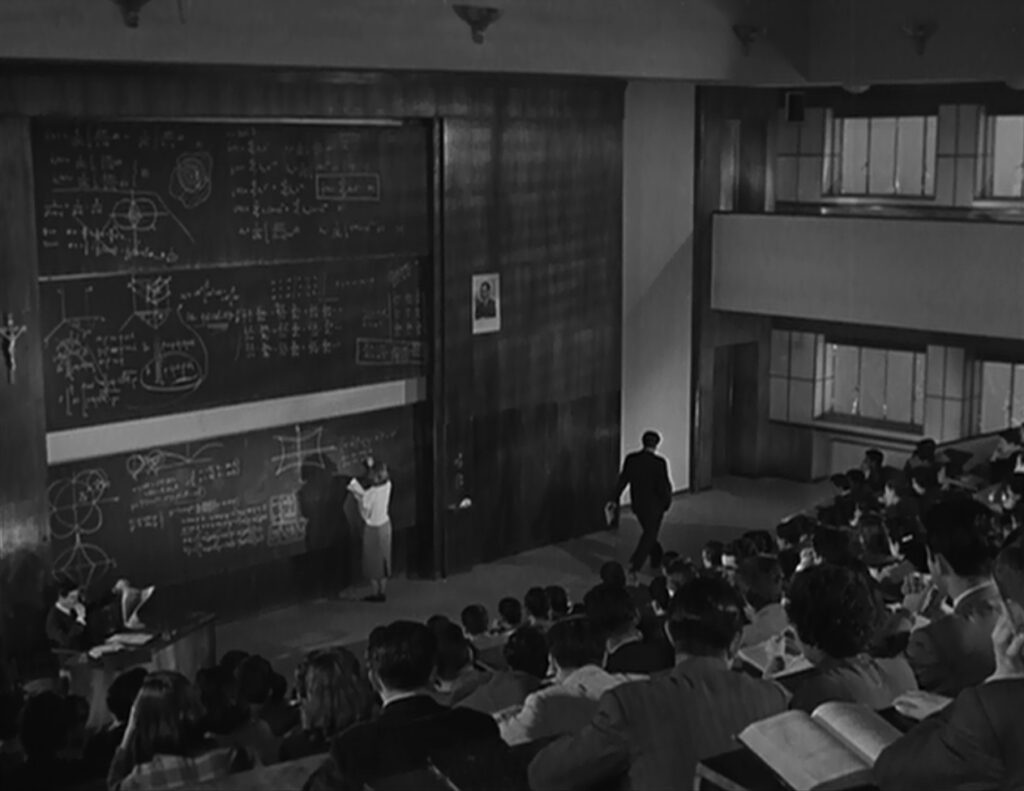
In a film where symmetry is so important – so much so that when Bardem was forced to append María José’s death at the end, he restored the original symmetry by introducing a cyclist to cause the accident – we should not ignore the fact that Juan’s transformation begins with a geometry problem, namely Matilde’s calculation of the outline of a torus. In Spanish a torus is “toro”, a homonym for “bull”, a symbol of Spain, as Rafa reminds us when he jokes that the Americans will want something typically Spanish like “Olé, olé, toreador!” In other words, Matilde, the only character who always seeks truth, represents the movie’s goal of describing Spain as it actually is (“the outline of the torus”). Like Matilde’s geometry problem, the movie describes Spain analytically, defining its outline in the contrast between social classes and in the symmetries which Bardem believed would ultimately right the imbalances dividing the country.
CONNECTIONS:
The Big Sleep – Each major character has a different relationship to the truth
L’avventura – Palindromic structure; similarity between crowds at Juan’s college and Messina
The Exterminating Angel – Truth emerges through repetitions
LIST OF CUTS THAT BRIDGE CONNECTED IDEAS:
6:04 – Rafa lists for María José the “personal effects” she might have carried with her on the highway, and comes to the word “lover”, whereupon it cuts to that precise lover, namely Juan, at his home.
9:41 – Juan is talking to his mother about his chances for promotion, ending his speech with “but…”, whereupon it cuts immediately to his sister at the party saying “My brother Juan is a failure.”
10:12 – We have just been watching Jorge holding forth at the party, and Rafa calls him “one of those rare men who can talk for hours while saying nothing”. Cut to a newsreel in a movie theater showing Jorge, holding forth in the same manner, promising to conclude his talk and fall silent (but breaking this promise). Juan is in the theater watching this.
11:24 – Juan has just left the theater after seeing María José’s cameo in the newsreel. Clearly thinking about her, it cuts directly to her face in her bedroom.
12:06 – María José reaches out to welcome her husband into bed. Cut to Juan getting into bed alone, in the same position on screen, as if fulfilling her wish for the lover over the husband.
12:25 – Juan blows smoke, and cut to María José, now with him, blowing smoke away with her hand.
13:01 – María José has just said to Juan “Let’s leave right away”. Cut to the classroom, where Juan will eventually tell his student Matilde to “Go away”.
15:13 – Cut from Juan holding his head in agony to horses pounding their hooves into a racetrack.
16:57 – Cut from Rafa’s laughter to children laughing at a clown.
24:27 – Rafa proposes the third term of his blackmail, to possess María José sexually; she says she must tell her husband, and he jokes that that’s his plan. Cut to a marriage ceremony on the words “…fidelity of wife to husband in body and soul”.
26:11 – Cut from a bourgeois woman chasing after children to a vendor in the slum blowing a horn to summon poor children.
30:46 – Cut back from children living in poverty to children of a wealthy family, in both cases seen from a high vantage point.
39:36 – Juan talks to María José of “people driving us apart”; cut to a close-up of her husband, Miguel.
42:19 – Cut from Rafa’s name, spoken by Miguel, to Rafa’s hands on the piano moving left to right.
45:41 – The same scene ends with Rafa’s hand playing a glissando (again moving left to right); cut to the flamenco musicians. Rafa has just said the answer (about the missing detail) will be revealed in the next act, and this is the scene where he will speak up.
53:31 – Cut from Rafa throwing a bottle through a window to a student’s bottle shattering a window at the university.
1:00:16 – Juan and Matilde wave to each other through the broken window. Cut to priests waving incense and holy water over a coffin at a funeral.
1:11:21 – Cut from Miguel looking at his wife, unable to understand her, to Doña Maria looking at Juan and saying she’s never understood him.
1:12:50 – Cut from Juan talking about “the other person” (his lover) to his mother, to a close-up identifying that person as María José.
1:14:35 – Cut from María José’s face in agony to a fire.
1:19:21 – Cut from Doña Maria saying the word “death” to the scene where her son will die.
1:23:44 – Miguel smashes his wife’s photo (note how the clock stops ticking) right before the scene of her death.